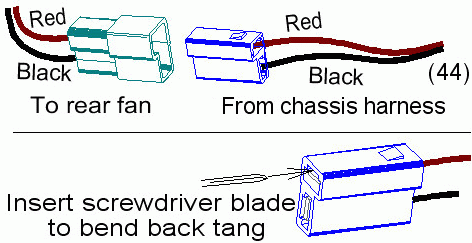Troubleshooting overheating problems
*Note!!! Some FIA wiring harnesses delivered in the last half of 2008 may have the fan connections reversed. See here for the proper connections.
Waterless Coolant Notes:
Since waterless coolant transfers heat less efficiently, the engine running temperature must be increased 10-30F in order to cool properly at idle. It's not a good idea to increase under-hood temperatures that much, unless you like fuel percolation in the carburetor.
Running hot at idle only
The cooling fan(s) normally turn on at 195F (90C), so the idling temperature might get to 215F (100C) with the fan running. This is normal. With 25% antifreeze and a 15psi cap, the boiling point of the mixture is more than 235F. Temperatures that high won't damage an engine.
Antifreeze Mixture Freezing Point 17% 20F -7C 25% 10F -12C 33% -1F -18C 40% -15F -25C 50% -30F -34C
- In general, antifreeze inhibits the heat transfer between the cooling fluid and metals, so it's advantageous to minimize its percentage if your engine is running hot. The addition of Red Line Water Wetter to the system is said to increase the cooling system efficiency too.
- Using a "crankshaft power-pulley" which slows down the water pump will aggravate overheating at idle. Instead, use a standard-diameter pulley and/or a high-volume pump.
- Thermostat: A 175F-185F temperature opening range is preferred. Using a lower opening temperature will not help if your idling temperature is higher than that. In either case, the thermostat will be open the same amount. If the temperature rises and falls periodically more than a few degrees, check that the thermostat has a bypass hole as described here. If there is a hole, the thermostat may be defective and should be replaced.
- Pressure cap: 15-18psi is recommended.
- Air in system: It's not unusual for air to accumulate in the intake manifold by the thermostat area, causing local hotspots in the cylinder head. You will get local boiling as a result. Bleed from a intake manifold fitting, i.e. the temperature sender.
- Check timing. Vacuum advance.
- Clear radiator fins
- Insulate exhaust
- Exhaust air from engine compartment
Testing Procedure
- Confirm that your gauge is reading correctly first, especially if the car is not boiling over.
- Check that you have flow in the system. With the radiator cap off and the system over 200F, look in the expansion tank for flow.
- Confirm that your fan is functioning. If it is not
Check the fuse
Chect the plug connection- Check that the fan is drawing air through the radiator in the correct direction, not blowing toward the front.
Running hot at speed
- Collapsing lower hose. Make sure that the long hose has an internal spring.
- Bad water pump
- Incorrect ignition timing, including sticking centrifigal advance.
- Lean carburetor jetting
- Clogged radiator.
Plug Connection At Fan
 On
the FIA harnesses made in late 2009, a manufacturing error may have
snuck through on some kits. Check that the colors of the ERA
harness and the
fan harness match.
On
the FIA harnesses made in late 2009, a manufacturing error may have
snuck through on some kits. Check that the colors of the ERA
harness and the
fan harness match.
If the wires are reversed, they can be reconfigured by inserting a small flat screwdriver (like a jeweler's screwdriver) into the plug end and pry the tang back. The wire can then be pulled out of the plug. Don't forget to pry the tang back out to the original "catch" position when you re-insert the connection.